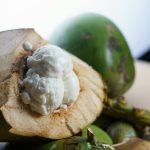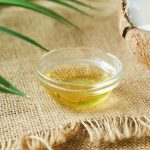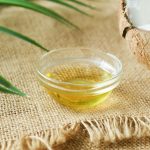When you get coconut oil on fabric, act quickly—blot gently, then sprinkle cornstarch or baking soda to absorb excess oil. Use a strong grease-cutting dish soap or laundry detergent, rub it in gently, and wash in the hottest water safe for your fabric. Avoid heat before cleaning to prevent setting the stain. Taking these steps helps you tackle greasy marks effectively. Keep going to discover other proven tips and prevention tricks that keep your fabrics spotless.
Table of Contents
Key Takeaways
- Blot coconut oil stains immediately with a clean cloth without rubbing to avoid deep fiber penetration.
- Apply cornstarch or talcum powder to absorb excess oil, letting it sit for 10-15 minutes before brushing off.
- Use a grease-cutting dish soap combined with baking soda, gently rubbing the mixture into the stain, then rinse with warm water.
- Treat stains with enzyme-based laundry detergent, allowing it to sit 5-10 minutes before washing in the hottest safe water.
- Always check fabric care labels and test stain removal methods on inconspicuous areas to prevent damage.
Understanding Coconut Oil Stains and Their Challenges
Although coconut oil is a natural product, it can leave stubborn stains on fabric that are tricky to remove. When coconut oil seeps into fibers, it creates greasy spots that attract dirt and resist water-based cleaning.
You’ll find that its thick consistency makes it cling tightly to fabric, especially delicate or porous materials. The challenge is that coconut oil isn’t just any stain—it’s a lipid, which means regular detergents mightn’t break it down effectively.
You’ll need to understand that heat can set these stains permanently, so knowing how they behave is essential. Recognizing the nature of coconut oil stains helps you choose the right approach to tackle them without making things worse or damaging your fabric.
Immediate Steps to Take When Coconut Oil Stains Occur
When you notice a coconut oil stain on your fabric, acting quickly can prevent it from setting and becoming permanent. First, gently blot the stain with a clean paper towel or cloth to absorb excess oil without spreading it. Avoid rubbing, as that pushes the oil deeper. Next, sprinkle some cornstarch or talcum powder over the stain to soak up remaining oil. Let it sit for 10-15 minutes before brushing it off.
| Step | Action |
|---|---|
| 1. Blot | Absorb excess oil without rubbing |
| 2. Apply powder | Use cornstarch or talcum powder |
| 3. Let sit | Wait 10-15 minutes |
| 4. Brush off | Remove powder gently |
Following these immediate steps helps ease later stain removal efforts.
Using Dish Soap and Baking Soda for Stain Removal
To tackle coconut oil stains, choose a dish soap that’s strong on grease but gentle on fabric.
Sprinkle baking soda directly on the stain to absorb excess oil before scrubbing gently.
Combining these two can boost your stain removal success without damaging your clothes.
Effective Soap Selection
Since coconut oil leaves a greasy residue, choosing the right soap is essential for effective stain removal.
You’ll want a dish soap that targets grease, like those designed for cutting through heavy oils. These soaps break down the coconut oil’s fats, lifting the stain from your fabric.
Avoid mild or moisturizing soaps—they won’t tackle the grease effectively. Look for dish soaps with strong degreasing agents but free from dyes or fragrances to prevent fabric irritation.
When combined with baking soda, the dish soap enhances stain removal by loosening oil particles. Apply the soap directly to the stain, gently rub it in, then let it sit briefly before rinsing.
Picking the right soap sets the foundation for successful coconut oil stain removal on your fabric.
Baking Soda Application Tips
Pairing dish soap with baking soda boosts your stain removal efforts by combining grease-cutting power with gentle abrasion.
To use this combo effectively, first sprinkle baking soda directly onto the coconut oil stain while it’s still fresh or slightly damp. Then, apply a few drops of dish soap over the powder.
Gently rub the mixture into the fabric using a soft brush or your fingers, focusing on the stained area. Let it sit for 10-15 minutes to allow the baking soda to absorb the oil and the soap to break it down.
Afterward, rinse with warm water and check the stain. Repeat if necessary before laundering as usual. This method helps lift stubborn oil stains without damaging your fabric.
How to Treat Coconut Oil Stains With Laundry Detergent
To tackle coconut oil stains, start by choosing a detergent with strong grease-fighting enzymes.
Before washing, apply a small amount of detergent directly to the stain and gently rub it in to break down the oil.
This pre-treatment step boosts your chances of removing the stain completely.
Detergent Selection Tips
Choosing the right laundry detergent plays an essential role in effectively removing coconut oil stains from fabric. You want a detergent that targets grease and oil, so look for formulas labeled as “heavy-duty” or “for grease stains.”
Enzymatic detergents work wonders because they break down oil molecules, making the stain easier to lift. Avoid detergents that are too mild or designed solely for delicate fabrics—they mightn’t have enough cleaning power.
Also, liquid detergents tend to penetrate oil stains better than powders. If you’re dealing with a stubborn stain, consider using a detergent with built-in stain removers or boosters.
Always check the product label for compatibility with your fabric type to prevent damage. Picking the right detergent sets you up for successful stain removal.
Pre-Treatment Techniques
Although detergent selection is essential, pre-treating coconut oil stains before washing can greatly boost your chances of complete removal. Start by gently blotting excess oil, then apply a small amount of liquid laundry detergent directly to the stain. Rub it in with your fingers or a soft brush, letting it sit for 5-10 minutes to break down the oils. Avoid using hot water during this step, as it can set the stain.
| Step | Action |
|---|---|
| 1 | Blot excess oil |
| 2 | Apply liquid detergent |
| 3 | Gently rub stain |
| 4 | Let detergent sit 5-10 minutes |
| 5 | Wash in warm water |
This method softens the stain, making your regular wash far more effective.
Alternative Home Remedies for Coconut Oil Stains
Wondering how to tackle coconut oil stains without harsh chemicals? You can try some effective home remedies using everyday items.
First, sprinkle baking soda or cornstarch on the stain to absorb excess oil. Let it sit for 15-30 minutes, then gently brush it off.
Sprinkle baking soda or cornstarch on the stain, let it absorb oil for 15-30 minutes, then brush off gently.
Next, apply a mixture of dish soap and warm water directly to the stain, scrubbing lightly with a soft brush or cloth.
White vinegar also works well—dilute it with water and dab onto the stain to break down the oil.
For stubborn spots, rub a small amount of lemon juice on the fabric to help lift the grease.
These natural treatments can save your clothes without damaging fibers or colors. Always test on a hidden area first to avoid any unwanted effects.
Tips for Washing and Drying Fabric After Stain Treatment
Once you’ve treated the coconut oil stain, you’ll want to wash the fabric carefully to prevent the oil from setting in permanently.
Start by checking the care label for washing instructions. Use the hottest water safe for the fabric to help break down any remaining oil.
Add a heavy-duty detergent or one designed for grease removal. Avoid using fabric softeners, as they can lock in stains.
Before drying, inspect the fabric to verify the stain is fully gone; heat from the dryer can set it permanently. If the stain persists, repeat the treatment and wash again.
When drying, air-dry the fabric or use a low heat setting. This approach protects your fabric and keeps it looking fresh after coconut oil stains.
Preventing Coconut Oil Stains in the Future
To keep coconut oil stains from ruining your clothes, you need to take simple precautions when handling the oil.
Preventing stains is always easier than removing them, so adopting these habits can save you time and frustration.
- Use a designated cloth or paper towel when applying coconut oil to avoid direct contact with fabric.
- Wear an apron or old clothes if you’re working with coconut oil in the kitchen or for beauty routines.
- Store coconut oil away from clothing areas to prevent accidental spills.
- Clean any small spills immediately with a dry cloth before the oil sets into the fabric.
Frequently Asked Questions
Can Coconut Oil Stains Damage Delicate Fabrics Like Silk or Wool?
You might think coconut oil stains could destroy delicate fabrics like silk or wool, but don’t panic! While they can leave marks, acting quickly and gently usually saves your precious garments from any lasting damage.
Is It Safe to Use Bleach on Coconut Oil Stains?
You shouldn’t use bleach on coconut oil stains, especially on delicate fabrics. Bleach can damage fibers and cause discoloration. Instead, try a gentle stain remover or mild detergent to protect your fabric while treating the stain.
How Long Should I Let Stain Removers Sit Before Washing?
Think of stain removers as superheroes resting before their big battle—they need about 10-15 minutes to work their magic. Don’t rush; giving them this time boosts their power before you wash the fabric clean.
Will Coconut Oil Stains Come Out After the Fabric Is Dry-Cleaned?
Coconut oil stains can be tricky to remove after dry cleaning because oil sets deeper when exposed to heat and solvents. You should point out the stain to your dry cleaner for targeted treatment before they start.
Can Professional Stain Removal Services Guarantee Coconut Oil Stain Removal?
Professional stain removal services can’t guarantee coconut oil stain removal because results depend on fabric type and stain age. However, they’ll use specialized treatments to improve your chances of restoring your garment effectively.
- The Use of Nonwovens in Construction and Civil Engineering - July 11, 2025
- The Use of Nonwovens in Construction and Civil Engineering - July 11, 2025
- The Use of Nonwovens in Construction and Civil Engineering - July 11, 2025







